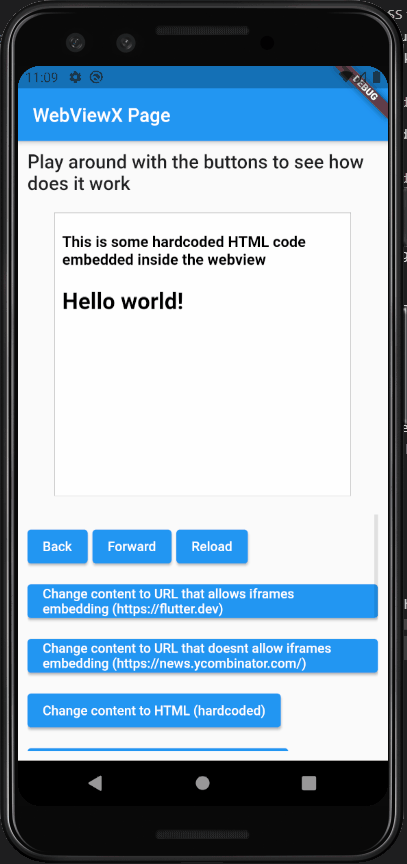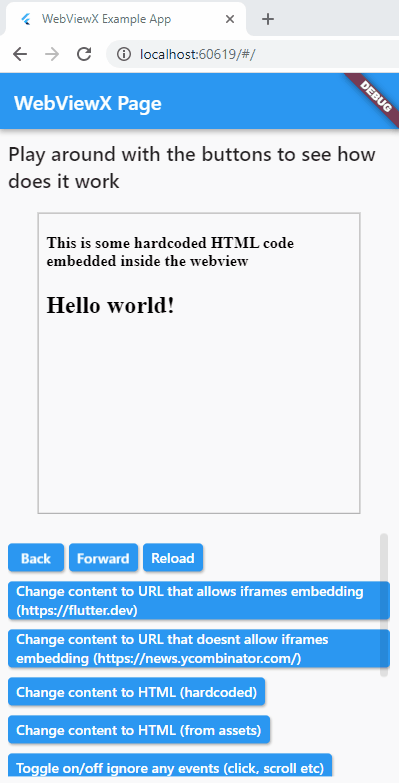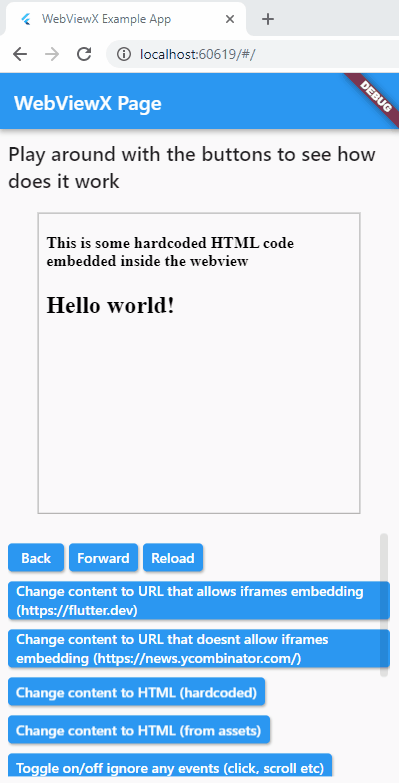webviewx 0.0.1  webviewx: ^0.0.1 copied to clipboard
webviewx: ^0.0.1 copied to clipboard
A feature-rich cross-platform webview using webview_flutter for mobile and iframe for web. JS interop-ready.

A feature-rich cross-platform webview using webview_flutter for mobile and iframe for web. JS interop-ready.
Getting started #
Gallery #
Basic usage #
- Create a
WebViewXControllerinside your stateful widget
WebViewXController webviewController;
- Add the WebViewX widget inside the build method, and set the
onWebViewCreatedcallback in order to retrieve the controller when the webview is initialized
WebViewX(
initialContent: '<h2> Hello, world! </h2>',
initialSourceType: SourceType.HTML,
onWebViewCreated: (controller) => webviewController = controller,
...
... other options
);
Important ! #
If you need to add other widgets on top of the webview (e.g. inside a Stack widget), you MUST wrap those widgets with a WebViewAware widget. This does nothing on mobile, but on web it allows widgets on top to intercept gestures. Otherwise, those widgets may not be clickable and/or the iframe will behave weird (unexpected refresh/reload - this is a well known issue).
Also, as a side note: If you happen to add widgets on top of the webview, wrap them and then you notice that the iframe still reloads unexpectedly, you should check if there are other widgets that sit on top without being noticed, or try to wrap InkWell, GestureRecognizer or Button widgets to see which one causes the problem.
- Interact with the controller (run the example app to see how does it work)
webviewController.loadContent(
'https://flutter.dev',
SourceType.URL,
);
webviewController.goBack();
webviewController.goForward();
...
...
Features #
-
Widget properties #
| Feature | Details |
|---|---|
String initialContent |
Initial webview content |
SourceType initialSourceType |
Initial webview content type (URL, URL_BYPASS or HTML) |
String userAgent |
User agent ( issues on web ) |
double width |
Widget's width (if null, it takes all available space) |
double height |
Widget's height (if null, it takes all available space) |
Function(WebViewXController controller) onWebViewCreated |
Callback that gets executed when the webview has initialized |
Set<EmbeddedJsContent> jsContent |
A set of EmbeddedJsContent, which is an object that defines some javascript which will be embedded in the page, once loaded (check the example app) |
Set<DartCallback> dartCallBacks |
A set of DartCallback, which is an object that defines a dart callback function, which will be called from javascript (check the example app) |
bool ignoreAllGestures |
Boolean value that specifies if the widget should ignore all gestures right after it is initialized |
JavascriptMode javascriptMode |
This specifies if Javascript should be allowed to execute, or not (allowed by default, you must allow it in order to use above features) |
AutoMediaPlaybackPolicy initialMediaPlaybackPolicy |
This specifies if media content should be allowed to autoplay when initialized (i.e when the page is loaded) |
void Function(String src) onPageStarted |
Callback that gets executed when a page starts loading (e.g. after you change the content) |
void Function(String src) onPageFinished |
Callback that gets executed when a page finishes loading |
void Function(WebResourceError error) onWebResourceError |
Callback that gets executed when there is an error when loading resources ( issues on web ) |
WebSpecificParams webSpecificParams |
This is an object that contains web-specific options. Theese are not available on mobile (yet) |
MobileSpecificParams mobileSpecificParams |
This is an object that contains mobile-specific options. Theese are not available on web (yet) |
-
Controller properties #
| Feature | Usage |
|---|---|
| Load URL that allows iframe embedding | webviewController.loadContent(URL, SourceType.URL) |
| Load URL that doesnt allow iframe embedding | webviewController.loadContent(URL, SourceType.URL_BYPASS) |
| Load URL that doesnt allow iframe embedding, with headers | webviewController.loadContent(URL, SourceType.URL_BYPASS, headers: {'x-something': 'value'}) |
| Load HTML from string | webviewController.loadContent(HTML, SourceType.HTML) |
| Load HTML from assets | webviewController.loadContent(HTML, SourceType.HTML, fromAssets: true) |
| Check if you can go back in history | await webviewController.canGoBack() |
| Check if you can go forward in history | await webviewController.canGoForward() |
| Reload current content | webviewController.reload() |
| Check if all gestures are ignored | webviewController.ignoringAllGestures |
| Set ignore all gestures | webviewController.setIgnoreAllGestures(value) |
| Evaluate "raw" javascript code | await webviewController.evalRawJavascript(JS) |
| Evaluate "raw" javascript code in global context ("page") | await webviewController.evalRawJavascript(JS, inGlobalContext: true) |
| Call a JS method | await webviewController.callJsMethod(METHOD_NAME, PARAMS_LIST) |
| Retrieve webview's content | await webviewController.getContent() |
Limitations and notes #
While this package aims to put together the best of both worlds, there are differences between web and mobile.
-
Running and building
First, this package was being developed while the default
web rendererwashtml. Now(Flutter 2, Dart 2.12), the default renderer iscanvaskit.From my experience, this package does behave a little bit weird on canvaskit, so you should use the
htmlrenderer.To do this, you have to run your ordinary
flutter run -d chromecommand with the--web-renderer htmlextra argument, like this:flutter run -d chrome --web-renderer htmlfor running and
flutter build web --web-renderer htmlfor building.
-
Behaviour when loading content
To make the web version (iframe) work as it is, I had to use this x-frame bypass in order to make a request to a pre-defined CORS proxy, which removes the headers that block iframe embeddings.
This might seem like a hack, and it really is, but I couldn't find any other way to make the iframe behave similar to the mobile webview (which is some kind of an actual browser, that's why everything works there by default).
Also, it should work on Safari too, as stated here.
-
Web navigation
On web, the history navigation stack is built from scratch because I couldn't handle iframe's internal history the right way.
Known issues and TODOs #
-
On web, user-agent and headers only work when using
SourceType.URL_BYPASS, and they only have effect the first time being used (view/web.dart) -
On web, it should be possible to send any errors caught when loading an
URL_BYPASSto a dart callback, which will then be sent through theonWebResourceErrorcallback, just like on the mobile version (utils/x_frame_options_bypass.dart) -
On web, it should be possible to add a custom proxy list without the js null-checking mess (
utils/x_frame_options_bypass.dart) -
Eventually (if possible), most if not all properties from
WebSpecificParamsandMobileSpecificParamsshould merge and theese two objects may disappear -
On mobile, the controller's value's source type becomes out of sync when moving back and forth in history. This happens because the url change is not yet intercepted and set the model accordingly (shouldn't be hard to fix).
-
On mobile, the controller's callJsMethod doesnt throw an error if the operation failed. Instead it only shows the error in console.
-
Add tests
-
List open, there may be others
Credits #
This package wouldn't be possible without the following:
- webview_flutter for the mobile version
- easy_web_view for ideas and starting point for the web version
- pointer_interceptor for fixing iframe issues when other widgets are on top of it (see above)
- x-frame-bypass for allowing the iframe to bypass websites' X-Frame-Options: deny/same-origin headers, thus allowing us to load any webpage (just like on mobile)
- https://cors.bridged.cc/ for the free CORS proxy
- https://api.codetabs.com/ for the free CORS proxy
- And last but not least, http://deversoft.ro (the company I work for) for motivating me throughout the development process



